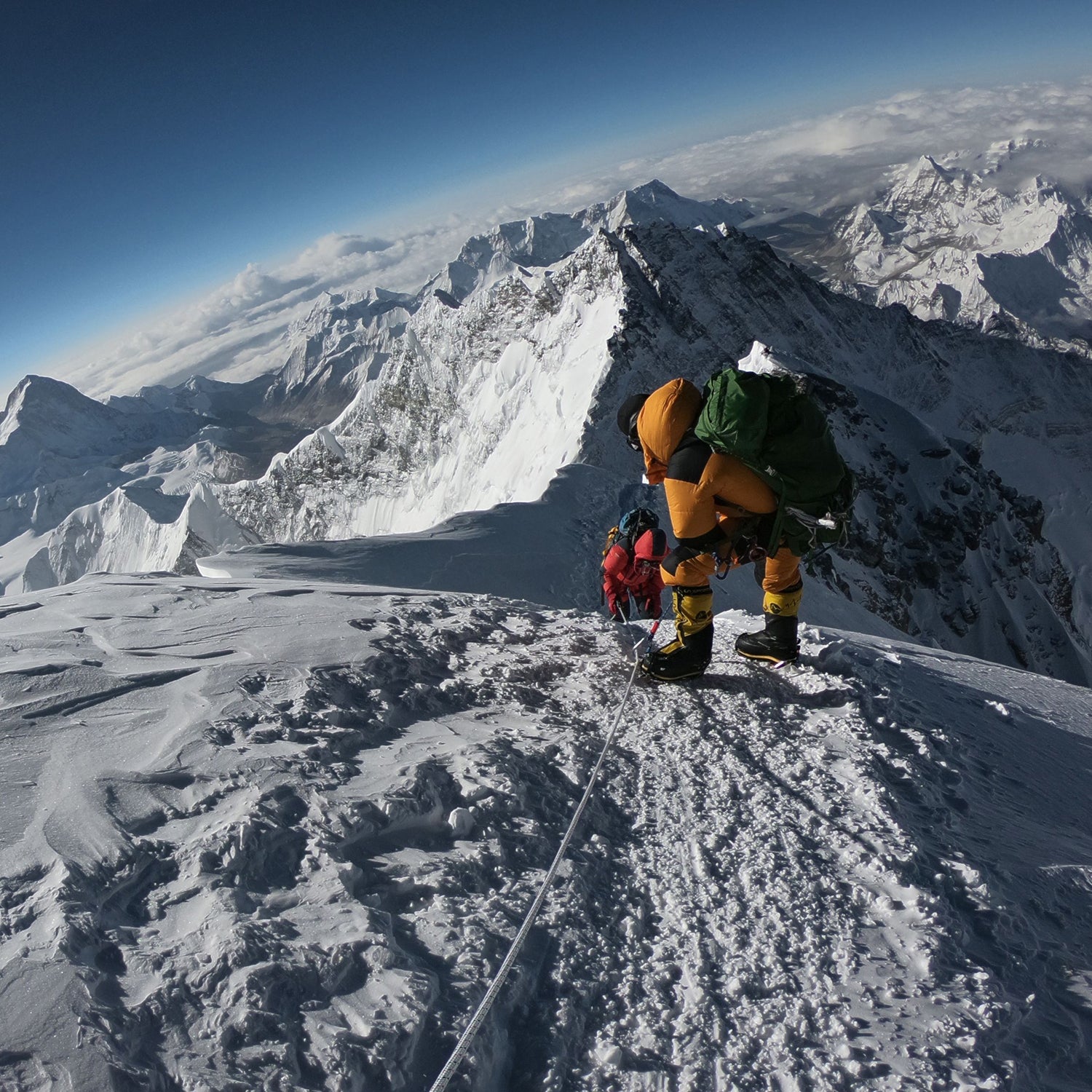Mountaineers Reinhold Messner and Peter Habeler first proved that humans could climb to╠řthe top of Mount Everest without using supplemental oxygen in 1978. But as of 2019, only 208 individuals╠řhave ever achieved this featÔÇö2.1 percent of the more than 10,000 people╠řto reach earthÔÇÖs tallest╠řpeak. Only one,╠ř, a Nepali╠řclimber known as the Snow Leopard, has pulled it off in winter.
But these exclusive clubs might soon have more╠řmembers, thanks to climate change.╠ř
As the world becomes hotter, the air pressure around Mount Everest is increasing, according to a ╠řpublished in the journal iScience. As air molecules heat up, they gain more energy and move around faster, creating more pressure and density and bringing the oxygen molecules closer together. Meaning:╠řthe higher the╠řair pressure, the more oxygen there is to breathe there,╠řeven at EverestÔÇÖs 29,029-foot summit.╠řThe findings are part of a 2019╠řNational Geographic expedition that studied╠řclimate impacts on the Himalayas.
With an average global temperature╠řtwo╠řdegrees Celsius (or 3.6╠řdegrees Fahrenheit) warmer than that of╠řpreindustrial timesÔÇöthe marker╠řwhen many climate scientists project weÔÇÖll see more dangerous climate-change impactsÔÇöair pressure is expected to increase a personÔÇÖs maximum oxygen uptake by up to 4.9 percent at the top of Everest, according to the study. ÔÇťItÔÇÖs╠řlike being lower in the atmosphere,ÔÇŁ says╠řthe studyÔÇÖs lead author, Tom Matthews, a climate scientist at Loughborough University in the United Kingdom.
Summiting Everest without supplemental oxygen is incredibly risky. ÔÇťWe always like to joke that youÔÇÖre taking ten╠řsteps per breath when youÔÇÖre using oxygen,ÔÇŁ says╠řPeter Athans, a world-renowned high-altitude climber who was involved in the National Geographic expedition. ÔÇťWhen youÔÇÖre not using oxygen, itÔÇÖs more like ten╠řbreaths per step.ÔÇŁ
Even the simplest tasks can be exhausting at that elevation, says Sandra Elvin, who coordinated the 2019 trip.╠řClimbers become hypersensitive to headaches, are more susceptible to frostbite and hypothermia, and have greater difficulty making decisions.╠ř
All of these risks are only amplified during the winter. Not only is the air pressure lower (on average itÔÇÖs 5 percent lower at the summit during the╠řwinter compared to its╠řhighest point during summer monsoon season), but freezing temperatures and high winds from the jet stream that╠řengulf╠řthe mountain can make the climb nearly impossible.╠ř
ThatÔÇÖs why most people who reach the summit without supplemental oxygen╠ř(nearly 82 percent, according to the study) do so in the pre-monsoon month of May, the most popular time of year on Everest, a result of╠řthe higher air pressure and╠řwarmer, less windy conditions. October, after the summer rains subside, has historically been the next most successful time to make such an attempt. Soon, however, climbers may be able to tackle this challenge in the wintertime as well.╠ř
As the study found, some of the most dramatic increases in air pressure are expected during this harsh season. If temperatures rise to the 3.6 degrees Fahrenheit mark, breathing in╠řthis extra oxygen during the winter could feel equivalent to shaving off nearly 118 metersÔÇö387 feetÔÇöfrom your climb.╠řÔÇťYou can pick a day that makes it feel like youÔÇÖre climbing in spring,ÔÇŁ Matthews says. ÔÇťIt doesnÔÇÖt have to be a difficult winter ascent in terms of oxygen availability.ÔÇŁ
New climbers forgoing extra oxygenÔÇöboth in the winter and the springÔÇöwould be joining a subset of climbers who each have their own philosophy on oxygen-less climbs. ÔÇťYou need motivation, you need something special, you need to do it for yourself,ÔÇŁ says╠řSpanish alpinist╠řAlex Txikon, who last year attempted to summit Everest during the winter without supplemental oxygen before being beaten back by bad storms. But, he admonishes, climbers shouldnÔÇÖt try to break records for the sake of it. ÔÇťItÔÇÖs not something you do to become famous,ÔÇŁ he says. ÔÇťThe first rule is not to destroy your career, your life, just because of the ego.ÔÇŁ
In addition to increased oxygen, the shifting seasons in a warmer world are further opening up opportunities to summit╠řEverest. When Athans first started climbing in the early 1980s, the winter season began in October. These days, he says, the monsoon season is extending and the traditional fall season is now starting later. ÔÇťWeÔÇÖve frequently seen in recent years that╠řlate November and December can be excellent times to climb,ÔÇŁ he says. During the╠řtwo-month-long National Geographic╠řexpedition, Matthews╠řhelped install the ╠řon Mount Everest;╠řsitting at 27,650 feet, it╠řwill╠řprovide╠řprecise╠řforecasts that can be of help to those planing an╠řascent.╠ř
There is the chance╠řthat better forecasts and seemingly more favorable conditions could spur riskier╠řbehavior on the mountain, according to Matthews. Having more specific weather information from the station high on╠řEverest╠řcould create a sense of safety that might cause╠řclimbers to miscalculate other critical details, like the amount of time the ascent╠řmight take or how much bad weather╠řthey can╠řendure. Still, Matthews says,╠řÔÇťItÔÇÖs╠řthe worldÔÇÖs best climbers that are at the absolute forefront of their profession, that are trying to do this in the first place, and I think really what this does is it helps fine-tune those preparations.ÔÇŁ╠ř
Panuru Sherpa, cofounder and executive director of Xtreme Climbers Treks and Expeditions, says╠řhe has noticed a change in EverestÔÇÖs air pressure and oxygen content in his 30 years of climbing (and ). But according to him, these factors╠řalone arenÔÇÖt╠řenough to make the mountain easier to overcome; climate change is also bringing with it new difficulties:╠řGlaciers are shifting and shrinking.╠řMore crevasses are appearing higher up the mountain. The notorious Khumbu Icefall could become more treacherous to pass. And , making it harder to scramble up as snowpack dwindles. Climate change, says Panuru, has definitely made it ÔÇťmore challenging and more dangerous to climb Everest.ÔÇŁ
Most experts agree. The final stretch to the summit might be a bit easier these days, says╠řAthans, while the bottom half of the mountain could become trickier to navigate. But╠řhe says╠řthatÔÇÖs just ÔÇťthe challenge of mountaineeringÔÇöbeing able to adapt to your environment, to be able to deal with whatever it throws at you.ÔÇŁ


